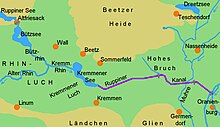Ruppiner Canal
The Ruppiner Canal is a navigable connection between the Rhin on the Ruppiner See and the Havel near Oranienburg . Its eastern part was a ditch between the Hohen Bruch and the Havel , which was built in the 17th century and used for rafting and drainage . In the 18th century this was called Schweitzergraben, after the inhabitants of the Hohenbruch Schweitz colony , through which the land north of the canal was reclaimed .

On September 5, 1787, King Friedrich Wilhelm II approved the project for the construction of today's navigable canal, which was to extend beyond Hohenbruch to the Kremmen and finally Ruppiner See. 130,000 thalers were estimated for the construction. By June 1790, 600 workers had completed the stretch from the Havel to Linum , and the entire canal a year later. This makes it one of the oldest canals in Brandenburg . Completion came too late for the reconstruction of Neuruppin , which was destroyed by fire in 1787 , but it was useful for transporting the peat from the Rhinluch to Berlin. The Altfriesack , Hohenbruch , Tiergarten and Friedenthal locks were built to overcome the difference in altitude between the higher Neuruppin lakes and the Havel . The Friedenthal lock was filled in around 1960 because there was no longer any need to use the Oranienburger Havel since the Oranienburg Canal was built . The Ruppin Canal therefore ends a few hundred meters before this former lock at the Oranienburg Canal Cross in the Oranienburg Canal. According to the development concept of the city of Oranienburg, a new construction of the Friedenthal lock is planned.
The name of the Ruppiner Canal is only correct from the Kremmener See; Above, the names Kremmener Rhin and Bützrhin are used for the canal stretch.
Locks
- Friedenthal lock in Oranienburg; Out of service
- Tiergarten lock in Oranienburg
- Hohenbruch lock in Hohenbruch , district of Kremmen

